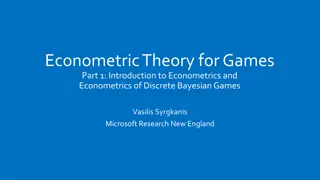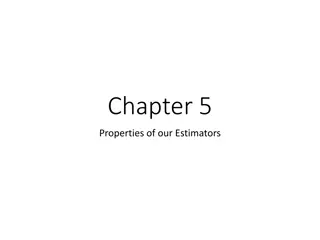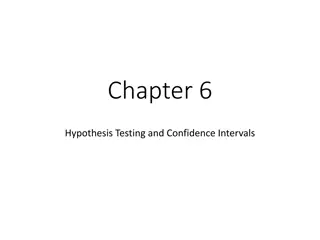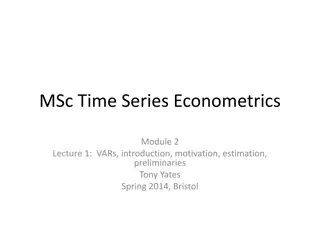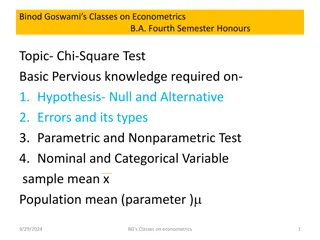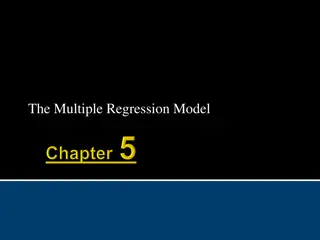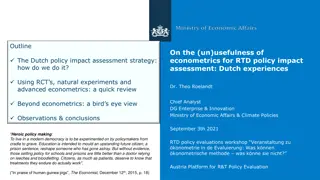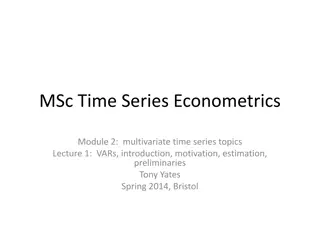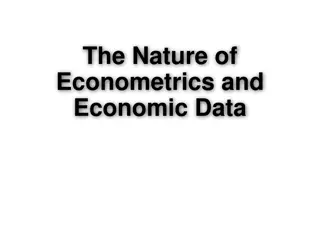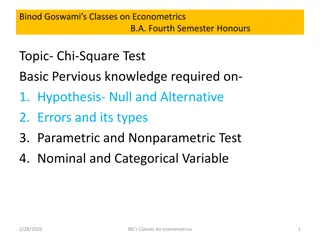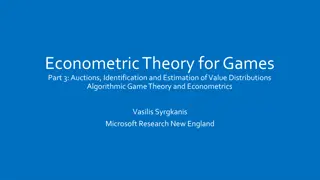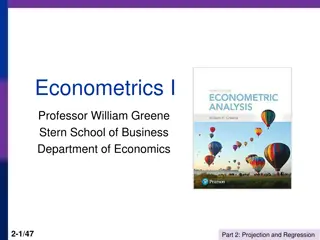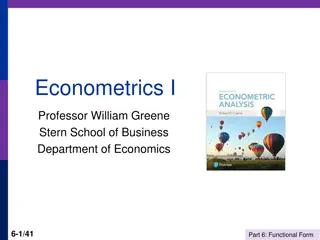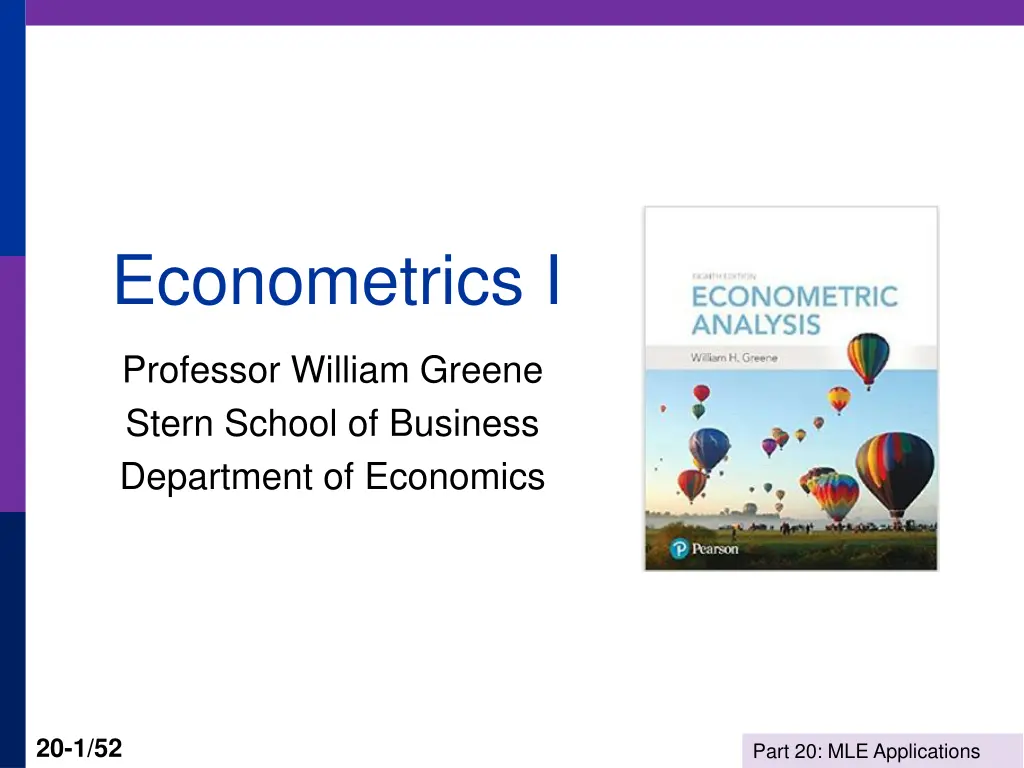
Applications of Maximum Likelihood Estimation in Econometrics
Explore the application of Maximum Likelihood Estimation (MLE) in econometrics through topics like Poisson regression models, doctor visit modeling, likelihood equations, and asymptotic variance. Understand MLE techniques for analyzing data and making statistical inferences in economic research and healthcare studies.
Download Presentation

Please find below an Image/Link to download the presentation.
The content on the website is provided AS IS for your information and personal use only. It may not be sold, licensed, or shared on other websites without obtaining consent from the author. If you encounter any issues during the download, it is possible that the publisher has removed the file from their server.
You are allowed to download the files provided on this website for personal or commercial use, subject to the condition that they are used lawfully. All files are the property of their respective owners.
The content on the website is provided AS IS for your information and personal use only. It may not be sold, licensed, or shared on other websites without obtaining consent from the author.
E N D
Presentation Transcript
Econometrics I Professor William Greene Stern School of Business Department of Economics 20-1/52 Part 20: MLE Applications
Econometrics I Part 20 MLE Applications and a Two Step Estimator 20-2/52 Part 20: MLE Applications
Poisson Regression Model Application of ML Estimation: Poisson Regression for a Count of Events exp( Poisson Probability: Prob[y=j]= j ) = , 0,1,... j ! j Regression Model: = E[y|x] = exp( x) Competing estimators: N Maximum Likelihood - Consistent and Efficient onlinear Least Squares - Consistent 20-3/52 Part 20: MLE Applications
Application: Doctor Visits German Individual Health Care data: n=27,236 Model for number of visits to the doctor: Poisson regression (fit by maximum likelihood) Income, Education, Gender 20-4/52 Part 20: MLE Applications
Poisson Model Density of Observed y j exp( ) x Prob[y = j | ] = i i i i ! j Log Likelihood n logL( | , ) = + y X log log ! y y i i i i = 1 i Likelihood Equations = Derivatives of log likelihood exp( ) exp( = = log = i i i i y = x x x x ) = i i i i i i L n + = x x 0 i 1 n n i i x x = = y i i i = = 1 1 i i 20-5/52 Part 20: MLE Applications
Asymptotic Variance of the MLE Variance of the first derivative vector: Observations are independent. First derivative vector is the sum of n independent terms. The variance is the sum of the variances. The variance of each term is V ar[ ( )] = Var[ Summing terms = i i x x x x x ] = y y i i i i i i i i log L n = x x X X Var i i i = 1 i 20-6/52 Part 20: MLE Applications
Estimators of the Asymptotic Covariance Asymptotic Covariance Matrix Conventional Estimator - Inverse of the information matrix "Usual" 1 ( ) n 1 i = x x X X i i = 1 i "Berndt, Hall, Hall, Hausman" (BHHH) 1 1 n n i ) ] x = g g ) ][( i x [( y y i i i i i i = = 1 1 i i 1 n i = 2 x x ( ) y i i i = 1 i 20-7/52 Part 20: MLE Applications
Robust Estimation Robust (Sandwich) Estimator H-1 (G G) H-1 ( ) Partial Effects [ | ] exp( E y = x x ( ) n 1 1 i 2 X X 1( = ) y x x X X i i i i x x x ) ( ) x = = = ( ) x ( ) x To use the delta method, we need ( ) ( ) = + x = x I ( ) x x D = ( ) x Est.Asy.Var D D Est.Asy.Var 20-8/52 Part 20: MLE Applications
Regression and Partial Effects +--------+--------------+----------------+--------+--------+----------+ |Variable| Coefficient | Standard Error |b/St.Er.|P[|Z|>z]| Mean of X| +--------+--------------+----------------+--------+--------+----------+ Constant| 1.72492985 .02000568 86.222 .0000 FEMALE | .31954440 .00696870 45.854 .0000 .47877479 HHNINC | -.52475878 .02197021 -23.885 .0000 .35208362 EDUC | -.04986696 .00172872 -28.846 .0000 11.3206310 +-------------------------------------------+ | Partial derivatives of expected val. with | | respect to the vector of characteristics. | | Effects are averaged over individuals. | | Observations used for means are All Obs. | | Conditional Mean at Sample Point 3.1835 | | Scale Factor for Marginal Effects 3.1835 | +-------------------------------------------+ +--------+--------------+----------------+--------+--------+----------+ |Variable| Coefficient | Standard Error |b/St.Er.|P[|Z|>z]| Mean of X| +--------+--------------+----------------+--------+--------+----------+ FEMALE | 1.01727755 .02427607 41.905 .0000 .47877479 HHNINC | -1.67058263 .07312900 -22.844 .0000 .35208362 EDUC | -.15875271 .00579668 -27.387 .0000 11.3206310 20-9/52 Part 20: MLE Applications
Comparison of Standard Errors Negative Inverse of Second Derivatives +--------+--------------+----------------+--------+--------+----------+ |Variable| Coefficient | Standard Error |b/St.Er.|P[|Z|>z]| Mean of X| +--------+--------------+----------------+--------+--------+----------+ Constant| 1.72492985 .02000568 86.222 .0000 FEMALE | .31954440 .00696870 45.854 .0000 .47877479 HHNINC | -.52475878 .02197021 -23.885 .0000 .35208362 EDUC | -.04986696 .00172872 -28.846 .0000 11.3206310 BHHH +--------+--------------+----------------+--------+--------+ |Variable| Coefficient | Standard Error |b/St.Er.|P[|Z|>z]| +--------+--------------+----------------+--------+--------+ Constant| 1.72492985 .00677787 254.495 .0000 FEMALE | .31954440 .00217499 146.918 .0000 HHNINC | -.52475878 .00733328 -71.559 .0000 EDUC | -.04986696 .00062283 -80.065 .0000 Why are they so different? Model failure. This is a panel. There is autocorrelation. 20-10/52 Part 20: MLE Applications
MLE vs. Nonlinear LS 20-11/52 Part 20: MLE Applications
Poisson Model Specification Issues Equi-Dispersion: Var[yi|xi] = E[yi|xi]. Overdispersion: If i = exp[ xi + i], E[yi|xi] = exp[ xi] Var[yi] > E[yi] (overdispersed) i ~ log-Gamma Negative binomial model i ~ Normal[0, 2] Normal-mixture model iis viewed as unobserved heterogeneity ( frailty ). Normal model may be more natural. Estimation is a bit more complicated. 20-12/52 Part 20: MLE Applications
Negative Binomial Specification Prob(Yi=j|xi) has greater mass to the right and left of the mean Conditional mean function is the same as the Poisson: E[yi|xi] = i=Exp( xi), so marginal effects have the same form. Variance is Var[yi|xi] = i(1 + i), is the overdispersion parameter; = 0 reverts to the Poisson. Poisson is consistent when NegBin is appropriate. Therefore, this is a case for the ROBUST covariance matrix estimator. (Neglected heterogeneity that is uncorrelated with xi.) 20-13/52 Part 20: MLE Applications
NegBin Model for Doctor Visits ---------------------------------------------------------------------- Negative Binomial Regression Dependent variable DOCVIS Log likelihood function -60134.50735 NegBin LogL Restricted log likelihood -103727.29625 Poisson LogL Chi squared [ 1 d.f.] 87185.57782 Reject Poisson model Significance level .00000 McFadden Pseudo R-squared .4202634 Estimation based on N = 27326, K = 8 Information Criteria: Normalization=1/N Normalized Unnormalized AIC 4.40185 120285.01469 NegBin form 2; Psi(i) = theta --------+------------------------------------------------------------- Variable| Coefficient Standard Error b/St.Er. P[|Z|>z] Mean of X --------+------------------------------------------------------------- Constant| .80825*** .05955 13.572 .0000 AGE| .01806*** .00079 22.780 .0000 43.5257 EDUC| -.03717*** .00386 -9.622 .0000 11.3206 FEMALE| .32596*** .01586 20.556 .0000 .47877 MARRIED| -.00605 .01880 -.322 .7477 .75862 HHNINC| -.46768*** .04663 -10.029 .0000 .35208 HHKIDS| -.15274*** .01729 -8.832 .0000 .40273 |Dispersion parameter for count data model Alpha| 1.89679*** .01981 95.747 .0000 --------+------------------------------------------------------------- 20-14/52 Part 20: MLE Applications
Zero Inflation ZIP Models Two regimes: (Recreation site visits) Zero (with probability 1). (Never visit site) Poisson with Pr(0) = exp[- xi]. (Number of visits, including zero visits this season.) Unconditional: Pr[0] = P(regime 0) + P(regime 1)*Pr[0|regime 1] Pr[j | j >0] = P(regime 1)*Pr[j|regime 1] Two inflation Number of children These are latent class models 20-15/52 Part 20: MLE Applications
Zero Inflation Models j i exp(- ) j! i Prob(y = j|x )= , =exp( x ) i i i i Zero Inflation = ZIP Prob(0 regime) = F( ) z i 20-16/52 Part 20: MLE Applications
A Zip Model for Major Derogatory Reports AmEx Credit Card Holders N = 13,444 Number of major derogatory reports in 1 year Issues: Nonrandom selection Excess zeros 20-17/52 Part 20: MLE Applications
20-18/52 Part 20: MLE Applications
A Hurdle Model Two part model: Model 1: Probability model for more than zero occurrences Model 2: Model for number of occurrences given that the number is greater than zero. Applications common in health economics Usage of health care facilities Use of drugs, alcohol, etc. 20-19/52 Part 20: MLE Applications
20-20/52 Part 20: MLE Applications
Hurdle Model Two Part Model Prob[y > 0] = F( 'z ) Prob[y=j] Prob[y>0| ] Prob[y=j] Prob[y Prob[y = j | y > 0, ] = x = = x 1 0| ] x A Poisson Hurdle Model with Logit Hurdle exp( 'z ) Prob[y>0| ]=1+exp( z exp(- ) j![1 'z ) j exp(- )] Prob[y=j|y>0, ]= x , =exp( 'x ) F( 'z )exp( 'x 'x ) )] E[y| , ] =Prob[y=0] x z 0+Prob[y>0] E[y|y>0] = 1-exp[-exp( Partial effects involve both parts of the model. 20-21/52 Part 20: MLE Applications
Negative Binomial Model with Hurdle 20-22/52 Part 20: MLE Applications
20-23/52 Part 20: MLE Applications
Application of Several of the Models Discussed in this Section 20-24/52 Part 20: MLE Applications
20-25/52 Part 20: MLE Applications
Poisson (log)Normal Mixture 20-26/52 Part 20: MLE Applications
Bivariate Random Effects 20-27/52 Part 20: MLE Applications
20-28/52 Part 20: MLE Applications
Exponential Regression Model 1 x = x ( | ) exp( / ), P y y i i i i i = = = 2 i x x exp( ) [ | ]; [ | ] E y Var y i i i i i i y n n = = x log ( | ) log i LogL P y i i i = = 1 i 1 i i gL log log 1 L y y L n n n = = + = x x 1 i i i i i i i 2 i = = = 1 1 1 i i i i i i = lo = x 0 Note since [ | ], E E y i i i 20-29/52 Part 20: MLE Applications
Variance of the First Derivative 1 = x ( | ) exp( / ), P y y i i i i i log y L n = x 1 i i = 1 i i log L = = x 0 Note since [ | ], E E y i i i log 1 1 L n n i i = = = 2 x x x x x XX Var [ | ] Var y i i i i i 2 2 = = 1 1 i i i i 20-30/52 Part 20: MLE Applications
Hessian 1 = x ( | ) exp( / ), P y y i i i i i log y L n = x 1 i i = 1 i i 2 log y y L n n i i = = x x x x i i i i i 2 i = = 1 1 i i i 2 log L = = X X, x because E[ | ] E y i i i 20-31/52 Part 20: MLE Applications
Variance Estimators Negative inverse of actual second derivatives Matrix 1 y = n i MLE x x x , exp i i i i = 1 i i Negative inverse of expected second derivatives = products of first derivatives (BHHH) 2 log L -1 XX, so [XX] E Sum of outer 1 2 y n x x 1 i i i = 1 i i "Robust" estimator in wide use 1 1 2 y y y n n n i i i x x x x x x 1 i i i i i i = = = 1 1 1 i i i i i i 20-32/52 Part 20: MLE Applications
Income Data Frequency .0 0 0 .4 3 8 .8 7 6 1 .3 1 4 1 .7 5 3 2 .1 9 1 2 .6 2 9 3 .0 6 7 HHNINC 20-33/52 Part 20: MLE Applications
Exponential Regression --> logl ; lhs=hhninc ; rhs = x ; model=exp $ Normal exit: 11 iterations. Status=0. F= -1550.075 ---------------------------------------------------------------------- Exponential (Loglinear) Regression Model Dependent variable HHNINC Log likelihood function 1550.07536 Restricted log likelihood 1195.06953 Chi squared [ 5 d.f.] 710.01166 Significance level .00000 McFadden Pseudo R-squared -.2970587 Estimation based on N = 27322, K = 6 --------+------------------------------------------------------------- Variable| Coefficient Standard Error b/St.Er. P[|Z|>z] Mean of X --------+------------------------------------------------------------- |Parameters in conditional mean function Constant| 1.77430*** .04501 39.418 .0000 AGE| .00205*** .00063 3.274 .0011 43.5272 EDUC| -.05572*** .00271 -20.539 .0000 11.3202 MARRIED| -.26341*** .01568 -16.804 .0000 .75869 HHKIDS| .06512*** .01399 4.657 .0000 .40272 FEMALE| -.00542 .01234 -.439 .6603 .47881 --------+------------------------------------------------------------- Note: ***, **, * = Significance at 1%, 5%, 10% level. ---------------------------------------------------------------------- 20-34/52 Part 20: MLE Applications
Variance Estimators histogram;rhs=hhninc$ reject ; hhninc=0$ namelist ; X = one, age,educ,married,hhkids,female $ loglinear ; lhs=hhninc ; rhs = x ; model=exp $ create ; thetai = exp(b'x) $ create ; gi = (hhninc/thetai - 1) ; gi2 = gi^2 $$ create ; hi = (hhninc/thetai) $ matrix ; Expected = <X'X> matrix ; Actual = <X'[hi]X> ; Stat(b,Actual,X) $ matrix ; BHHH = <X'[gi2]X> ; Stat(b,BHHH,X) $ matrix ; Robust = Actual * X'[gi2]X * Actual ; Stat(b,Robust,X) $ ; Stat(b,Expected,X)$ 20-35/52 Part 20: MLE Applications
--------+-------------------------------------------------- Variable| Coefficient Standard Error b/St.Er. P[|Z|>z] --------+-------------------------------------------------- --> matrix ; Expected = <X'X> ; Stat(b,Expected,X)$ Constant| 1.77430*** .04548 39.010 .0000 AGE| .00205*** .00061 3.361 .0008 EDUC| -.05572*** .00269 -20.739 .0000 MARRIED| -.26341*** .01558 -16.902 .0000 HHKIDS| .06512*** .01425 4.571 .0000 FEMALE| -.00542 .01235 -.439 .6605 --> matrix ; Actual = <X'[hi]X> ; Stat(b,Actual,X) $ Constant| 1.77430*** .11922 14.883 .0000 AGE| .00205 .00181 1.137 .2553 EDUC| -.05572*** .00631 -8.837 .0000 MARRIED| -.26341*** .04954 -5.318 .0000 HHKIDS| .06512* .03920 1.661 .0967 FEMALE| -.00542 .03471 -.156 .8759 --> matrix ; BHHH = <X'[gi2]X> ; Stat(b,BHHH,X) $ Constant| 1.77430*** .05409 32.802 .0000 AGE| .00205*** .00069 2.973 .0029 EDUC| -.05572*** .00331 -16.815 .0000 MARRIED| -.26341*** .01737 -15.165 .0000 HHKIDS| .06512*** .01637 3.978 .0001 FEMALE| -.00542 .01410 -.385 .7004 --> matrix ; Robust = Actual * X'[gi2]X * Actual $ Constant| 1.77430*** .28500 6.226 .0000 AGE| .00205 .00481 .427 .6691 EDUC| -.05572*** .01306 -4.268 .0000 MARRIED| -.26341* .14581 -1.806 .0708 HHKIDS| .06512 .09459 .689 .4911 FEMALE| -.00542 .08580 -.063 .9496 Estimates 20-36/52 Part 20: MLE Applications
Testing Hypotheses Wald tests, using the familiar distance measure Likelihood ratio tests: LogLU LogLR LogLU > logLR for any nested restrictions 2(LogLU logLR) chi-squared [J] = log likelihood without restrictions = log likelihood with restrictions 20-37/52 Part 20: MLE Applications
Testing the Model +---------------------------------------------+ | Poisson Regression | | Maximum Likelihood Estimates | | Dependent variable DOCVIS | | Number of observations 27326 | | Iterations completed 7 | | Log likelihood function -106215.1 | Log likelihood | Number of parameters 4 | | Restricted log likelihood -108662.1 | Log Likelihood with only a | McFadden Pseudo R-squared .0225193 | constant term. | Chi squared 4893.983 | 2*[logL logL(0)] | Degrees of freedom 3 | | Prob[ChiSqd > value] = .0000000 | +---------------------------------------------+ Likelihood ratio test that all three slopes are zero. NOTE: -2logL reported by some computer programs is meaningless. 20-38/52 Part 20: MLE Applications
Wald Test --> MATRIX ; List ; b1 = b(2:4) ; v11 = varb(2:4,2:4) ; B1'<V11>B1$ Matrix B1 Matrix V11 has 3 rows and 1 columns. has 3 rows and 3 columns 1 1 2 3 +-------------- +------------------------------------------ 1| .31954 1| .4856275D-04 -.4556076D-06 .2169925D-05 2| -.52476 2| -.4556076D-06 .00048 -.9160558D-05 3| -.04987 3| .2169925D-05 -.9160558D-05 .2988465D-05 Matrix Result has 1 rows and 1 columns. 1 +-------------- 1| 4682.38779 LR statistic was 4893.983 20-39/52 Part 20: MLE Applications
Chow Style Test for Structural Change Does the same model apply to 2 (G) groups? For linear regression we used the "Chow" (F) test. For models fit by maximum likelihood, we use a test based on the likelihood function. The same model is fit t ( 1 Degrees of freedom = (G-1)K. o the pooled sample and to each group. ) G Chi squared = 2 log log L L g pooled = g 20-40/52 Part 20: MLE Applications
Poisson Regressions ---------------------------------------------------------------------- Poisson Regression Dependent variable DOCVIS Log likelihood function -90878.20153 (Pooled, N = 27326) Log likelihood function -43286.40271 (Male, N = 14243) Log likelihood function -46587.29002 (Female, N = 13083) --------+------------------------------------------------------------- Variable| Coefficient Standard Error b/St.Er. P[|Z|>z] Mean of X --------+------------------------------------------------------------- Pooled Constant| 2.54579*** .02797 91.015 .0000 AGE| .00791*** .00034 23.306 .0000 43.5257 EDUC| -.02047*** .00170 -12.056 .0000 11.3206 HSAT| -.22780*** .00133 -171.350 .0000 6.78543 HHNINC| -.26255*** .02143 -12.254 .0000 .35208 HHKIDS| -.12304*** .00796 -15.464 .0000 .40273 --------+------------------------------------------------------------- Males Constant| 2.38138*** .04053 58.763 .0000 AGE| .01232*** .00050 24.738 .0000 42.6528 EDUC| -.02962*** .00253 -11.728 .0000 11.7287 HSAT| -.23754*** .00202 -117.337 .0000 6.92436 HHNINC| -.33562*** .03357 -9.998 .0000 .35905 HHKIDS| -.10728*** .01166 -9.204 .0000 .41297 --------+------------------------------------------------------------- Females Constant| 2.48647*** .03988 62.344 .0000 AGE| .00379*** .00048 7.940 .0000 44.4760 EDUC| .00893*** .00234 3.821 .0001 10.8764 HSAT| -.21724*** .00177 -123.029 .0000 6.63417 HHNINC| -.22371*** .02767 -8.084 .0000 .34450 HHKIDS| -.14906*** .01107 -13.463 .0000 .39158 --------+------------------------------------------------------------- 20-41/52 Part 20: MLE Applications
Chi Squared Test Namelist; X = one,age,educ,hsat,hhninc,hhkids$ Sample ; All $ Poisson ; Lhs = Docvis ; Rhs = X $ Calc ; Lpool = logl $ Poisson ; For [female = 0] ; Lhs = Docvis ; Rhs = X $ Calc ; Lmale = logl $ Poisson ; For [female = 1] ; Lhs = Docvis ; Rhs = X $ Calc ; Lfemale = logl $ Calc ; K = Col(X) $ Calc ; List ; Chisq = 2*(Lmale + Lfemale - Lpool) ; Ctb(.95,k) $ +------------------------------------+ | Listed Calculator Results | +------------------------------------+ CHISQ = 2009.017601 *Result*= 12.591587 The hypothesis that the same model applies to men and women is rejected. 20-42/52 Part 20: MLE Applications
GARCH Models: A Model for Time Series with Latent Heteroscedasticity Bollerslev/Ghysel, 1974 20-43/52 Part 20: MLE Applications
ARCH Model 20-44/52 Part 20: MLE Applications
GARCH Model 20-45/52 Part 20: MLE Applications
Estimated GARCH Model ---------------------------------------------------------------------- GARCH MODEL Dependent variable Y Log likelihood function -1106.60788 Restricted log likelihood -1311.09637 Chi squared [ 2 d.f.] 408.97699 Significance level .00000 McFadden Pseudo R-squared .1559676 Estimation based on N = 1974, K = 4 GARCH Model, P = 1, Q = 1 Wald statistic for GARCH = 3727.503 --------+------------------------------------------------------------- Variable| Coefficient Standard Error b/St.Er. P[|Z|>z] Mean of X --------+------------------------------------------------------------- |Regression parameters Constant| -.00619 .00873 -.709 .4783 |Unconditional Variance Alpha(0)| .01076*** .00312 3.445 .0006 |Lagged Variance Terms Delta(1)| .80597*** .03015 26.731 .0000 |Lagged Squared Disturbance Terms Alpha(1)| .15313*** .02732 5.605 .0000 |Equilibrium variance, a0/[1-D(1)-A(1)] EquilVar| .26316 .59402 .443 .6577 --------+------------------------------------------------------------- 20-46/52 Part 20: MLE Applications
2 Step Estimation (Murphy-Topel) Setting, fitting a model which contains parameter estimates from another model. Typical application, inserting a prediction from one model into another. A. Procedures: How it's done. B. Asymptotic results: 1. Consistency 2. Getting an appropriate estimator of the asymptotic covariance matrix The Murphy - Topel result Application: Equation 1: Number of children Equation 2: Labor force participation 20-47/52 Part 20: MLE Applications
Setting Two equation model: Model for y1 = f(y1 | x1, 1) Model for y2 = f(y2 | x2, 2, x1, 1) (Note, not simultaneous or even recursive. ) Procedure: Estimate 1 by ML, with covariance matrix (1/n)V1 Estimate 2 by ML treating 1 as if it were known. Correct the estimated asymptotic covariance matrix, (1/n)V2 for the estimator of 2 20-48/52 Part 20: MLE Applications
Murphy and Topel (1984,2002) Results Both MLEs are consistent = + Asy.Var[ ] ( ' ' ') V V CVC RVC CVR V 1 n 2 2 2 1 1 1 2 = Asy.Var n[ ] V 1 1 1 = Asy.Var n[ ]| V 2 2 2 1 logL logL 1 n E C = 2 2 2 1 logL logL 1 n E R = 2 1 2 1 20-49/52 Part 20: MLE Applications
M&T Computations First equation: =MLE, 1 1 1 H i1 g g i1 = N N or V 1 n 1 n = i 1 = i 1 1 i1 Second equation: =MLE| 2 1 1 1 H , i3 g g i2 = N N or V 1 n 1 n = i 1 = i 1 2 i2 lnf (y | , , ) lnf (y | , , , ) x x x x 1 n C N = 2 2 2 2 1 1 2 2 2 2 1 1 = i 1 2 1 lnf (y | , , , ) lnf (y | , ) x x x 1 n R N = 2 2 2 2 1 1 1 1 1 1 = i 1 2 1 20-50/52 Part 20: MLE Applications

